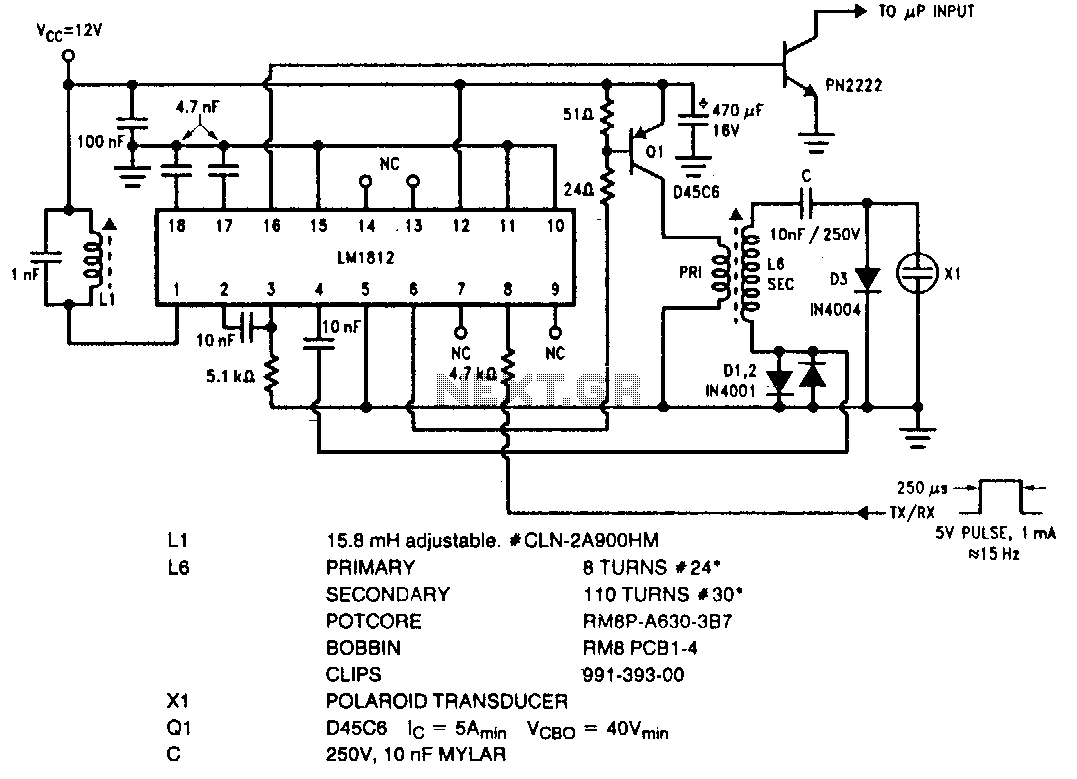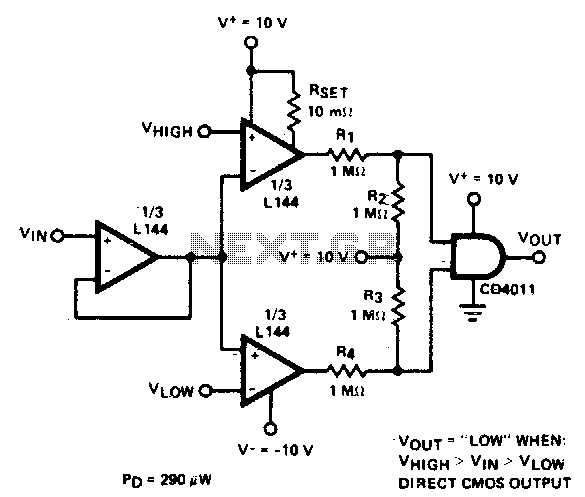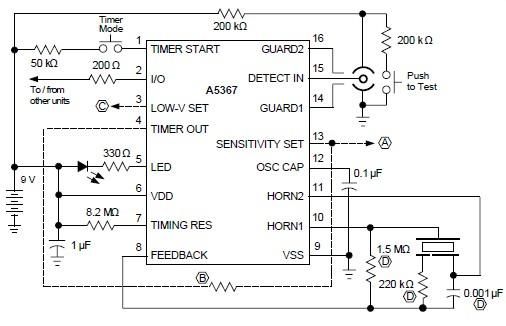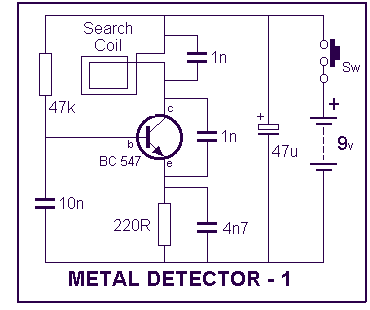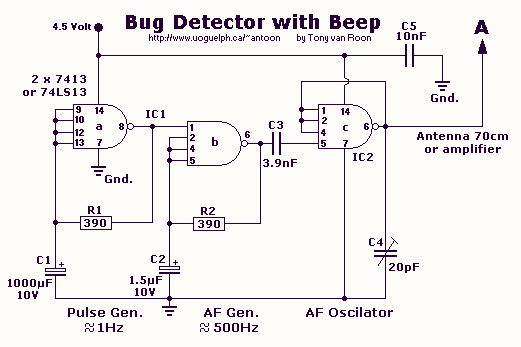
Ultrasonic Movement Detector
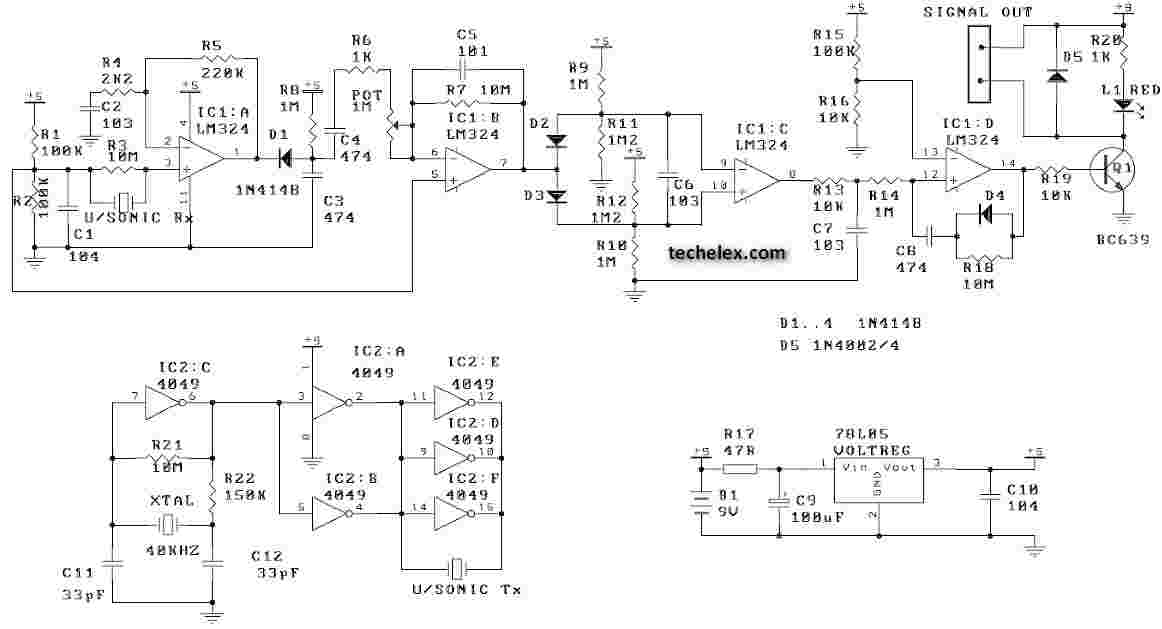
This ultrasonic movement detector circuit utilizes a crystal-locked circuit to achieve maximum performance from the ultrasonic transmitter. The detection circuit is designed to be more sensitive. It is advisable to verify all components against the parts list. Generally, it is easier to solder the lowest profile components first, such as the resistors and diodes. Ensure that the diodes are oriented correctly; the black circle or band on the diodes must align with the bar of the diode symbol on the overlay. There are numerous resistors; use the resistor color code printed on the back of the header card to determine each value. The 40 kHz crystal can be installed in either orientation, and holes are provided to secure its case to the PCB. One of the leads cut from the resistors can be used for this purpose, or the wire can be quickly soldered to the case of the crystal. The ultrasonic transmitter is marked with a 'T' suffix on the number stamped underneath, while the receiver has an 'R' suffix. Both can be soldered in either orientation on the pads under the PCB, but they must be positioned straight out at 90 degrees from the PCB. Battery operation is not recommended for this detector, as the sensitivity will change with decreasing battery potential, particularly if the unit is frequently triggered (e.g., detecting a door opening). It is preferable to use a power supply of 9V to 12V DC, with a maximum of 15V, although this may require replacing the 78L05 with a 7805. After connecting the power, allow the unit to stand for at least 20 seconds for the circuit to stabilize electrically. The schematic indicates that the setting of the trimpot value is critical for the operation of the detector. A 1M trimpot is provided, which should be set to approximately 400K by visual estimation. Below about 300K, the detector may become too sensitive and self-trigger. Trial and error will help determine the optimal setting for specific requirements. This circuit is highly sensitive; even minor air movements (e.g., hot air rising or wind blowing) can trigger it when the trimpot is set near the most sensitive position. Therefore, it is essential to adjust it according to specific needs. The transmitter emits a steady ultrasonic tone at 40 kHz, with a wavelength of approximately 6 mm. Any reflected sound is detected by the ultrasonic receiver, and the signal is amplified by IC1:A and IC1:B. IC1:A is self-biasing via C2 and R5. The time constant of the first amplifier is configured to allow the 40 kHz signal to pass. Between the first and second amplifiers, there is a negative peak detector (D1 and R8) that follows the envelope of the 40 kHz signal. In the absence of movement, the envelope remains a straight line. The time constant of IC1:B is significantly slower, enabling it to follow this envelope. All amplifiers are AC-coupled to avoid DC bias problems. The signal is then processed through a window detector (IC1:C), which detects both positive and negative pulses. When no movement is detected, the potential at pin 7 remains at half the supply potential, preventing D2 and D3 from conducting. The potential at pin 8 is low. If the signal increases, D3 conducts, causing the output to go high. Conversely, if the signal decreases, D2 conducts, also resulting in a high output. This characteristic gives the circuit its name, as it detects potentials that move both above and below a specified range. A low-pass filter eliminates unwanted spurious signals, after which an amplifier (IC1:D) configured as a monostable flip-flop converts any signal that passes through the filter into a substantial pulse to activate the BC639. This action turns on the LED and provides a signal output to drive a relay or any other device intended to be signaled. The time constant of the monostable flip-flop is approximately half a second, determined by C8 and R10. D4 is employed to separate the charge and discharge time constants, allowing the circuit to switch on immediately upon detecting movement while providing about a half-second delay for reset. Poor soldering is the most likely cause of operational issues, thus all solder joints should be inspected carefully.This ultrasonic movement detector circuit uses a crystal locked circuit to get maximum performance from the ultrasonic transmitter. However, the detection circuit is different. think it is more sensitive. Check all the components against the parts list. It is generally easier to solder in the lowest height components first the resistors and di odes. Make sure to get the diodes in the correct way. The black circle or band on the diodes must match the bar of the diode symbol on the overlay. There are a lot of resistors. Use the resistor color code printed on the back of the header card to work out each value. The 40 kHz crystal can be inserted either way. Holes have been provided to secure its case to the PCB. Use one of the leads cut from the resistors. You can also quickly solder the wire to the case of the crystal. The ultrasonic transmitter has a T suffix on the number stampedunderneath it. The receiver has an R suffix. Each may be soldered either way around on the pads under the PCB. Make sure to get them both pointing straight out at 90o from the PCB. Battery operation is not recommended for this detector. As the battery potential decreases the sensitivity will change. This is partcuarly so if the unit is triggered often (as in detecting a door opening. ) It is better to use a power supply. Use 9V to 12V DC. You could go to a maximum of 15V but you may have to replace the 78L05 by a 7805. Immediately after you connect the power let the unit stand for at least 20 seconds so whole circuit will settle down electrically. The schematic shows that the setting of the trimpot value is critical to the operation of the detector.
We provide a 1M trimpot. Set it to about 400K by eye. We have found that below about 300K the detector is too sensitive and will self-trigger. Trial and error will show the best setting for your particular requirement. Note that this circuit is very sensitive. Even air moving (hot air rising, wind blowing) will trigger it when the trimpot is set near the most sensitive position. That is why we say to set it for your particular need. The transmitter sends out a steady ultrasonic tone at 40kHz. At this frequency the wavelength is about 6 mm. Any reflected sound is detected by ultrasonic receiver. The signal is then amplified by IC1:A and IC1:B. IC1:A is selfbiasing via C2 & R5. The time constant of the first amplifier is set to let the 40kHz signal through. Between the first & second amplifier there is a negative peak detector (diode D1 & R8) which follows the envelope of the 40kHz signal.
If there is no movement the envelope is just a straight line. The time constant of IC1:B is much slower so that it will follow this envelope. All the amplifiers are AC coupled to prevent DC bias problems. Then the signal is fed through a window detector IC1:C which detects both positive and negative pulses. When there is no movement the potential at pin 7 sits at half the supply potential and neither D2 or D3 can conduct.
The potential at pin 8 is low. If the signal rises D3 conducts causing the output to go high. If the signal falls then D2 conducts which also causes the output to go high. Thus the name window detector circuit because it detects potentials which move both below and above a given range. A low pass filter screens out unwanted spurious signals, then an amp IC1:D set up as a monostable flip flop converts any signal that gets through the filter into a substantial pulse to turn on the BC639.
This turns on the LED and provides a Signal Out to drive a separate relay or any other device you may wish to signal to. The time constant of the monostable flip-flop is about half a second and is set by C8 & R10. D4 is used to separate the charge & discharge time constants. It lets the circuit switch on immediately movement is detected but allows about a 1/2 second delay for the reset.
Poor soldering is the most likely reason. Check all solder joints carefully un 🔗 External reference
We provide a 1M trimpot. Set it to about 400K by eye. We have found that below about 300K the detector is too sensitive and will self-trigger. Trial and error will show the best setting for your particular requirement. Note that this circuit is very sensitive. Even air moving (hot air rising, wind blowing) will trigger it when the trimpot is set near the most sensitive position. That is why we say to set it for your particular need. The transmitter sends out a steady ultrasonic tone at 40kHz. At this frequency the wavelength is about 6 mm. Any reflected sound is detected by ultrasonic receiver. The signal is then amplified by IC1:A and IC1:B. IC1:A is selfbiasing via C2 & R5. The time constant of the first amplifier is set to let the 40kHz signal through. Between the first & second amplifier there is a negative peak detector (diode D1 & R8) which follows the envelope of the 40kHz signal.
If there is no movement the envelope is just a straight line. The time constant of IC1:B is much slower so that it will follow this envelope. All the amplifiers are AC coupled to prevent DC bias problems. Then the signal is fed through a window detector IC1:C which detects both positive and negative pulses. When there is no movement the potential at pin 7 sits at half the supply potential and neither D2 or D3 can conduct.
The potential at pin 8 is low. If the signal rises D3 conducts causing the output to go high. If the signal falls then D2 conducts which also causes the output to go high. Thus the name window detector circuit because it detects potentials which move both below and above a given range. A low pass filter screens out unwanted spurious signals, then an amp IC1:D set up as a monostable flip flop converts any signal that gets through the filter into a substantial pulse to turn on the BC639.
This turns on the LED and provides a Signal Out to drive a separate relay or any other device you may wish to signal to. The time constant of the monostable flip-flop is about half a second and is set by C8 & R10. D4 is used to separate the charge & discharge time constants. It lets the circuit switch on immediately movement is detected but allows about a 1/2 second delay for the reset.
Poor soldering is the most likely reason. Check all solder joints carefully un 🔗 External reference
